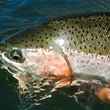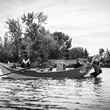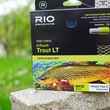Fly anglers are overloaded with gear choices—rods, reels, boots, waders, lines, packs, bags, boxes, vests, apparel and more. It seems harder and harder to know what's worth coveting and what's worth ignoring. Gear reviews are a great way to explore in-depth what might be right for you, but not every piece of gear is suited to a full-length review and, even if it were, there's simply too much of it to get to. With that in mind, we periodically showcase what's working for us right now, to hopefully offer more helpful feedback on gear that's worth a second look.
All gear is welcome here: new, old, cheap, pricey, and so on. The goal is to provide useful feedback on gear that works—not to help gin up marketing for new products. Sometimes, great gear has just hit the market, other times it's been here doing good work all along. And, as always, our feedback comes with a promise: Unlike many magazines that publish gear roundups for products they've never so much as seen in person let alone put to work, we've actually used and field tested every piece of gear we write about. Oh, and while we don't do the holiday gift guide thing that's so profanely ubiquitous these days, with the holidays approaching you might just find a good gift idea or two below.
Scott Swing
Anyone who has spent time swinging flies with me would likely spit out their coffee if they ever heard me call myself a “perfectionist” when it comes to two-handed casting. But doing so wouldn’t be entirely misleading. The world is filled with two-hand casters content to do little more than get the fly out there with some reasonable level of competence. There’s a reason for this: they want to catch fish. In other words, they’re the sensible ones. While I most certainly don’t demand of myself an exquisitely formed D-loop and a cast that unrolls in a manner worthy of slow-motion capture, try as I might, I can’t stomach tossing flaccid, lazy loops or casts devoid of energy. Part of this is foolish pride, but it’s also because proper casts fish better.
These days, I’m not on the river with a long rod in hand nearly as often as I’d like to be. I’m rusty. So when I inevitably uncork a dud — even if it lands at a fishable distance, in generally the area I intended it to — I’m prone to piss and moan, hurriedly strip it back in frustration, and try again when I should just let it fish. If I repeat my failed performance a time or two, the situation escalates and dissection ensues. Did I place my anchor correctly? Cut off my swing? Blow my D-loop by accelerating too fast? Or maybe too slow? Do I have too heavy or too light of a head on? Things rarely improve from here.
For the last few months, I’ve been fishing Scott’s new Swing two-handed rods (pictured at top). Specifically, the 14’1” 9-weight Swing “Viking Stick,” and while I no doubt need more time with it, I’ve repeatedly found myself wondering whether it might be the best two-hand rod I’ve ever cast. Where other rods have left me struggling to find the right tempo, fiddling with head and tip changes in an attempt to solve inadequately identified weak points in my casting, and so on, the Swing has let me get back to doing what I’m knee-deep in cold water to do: fish.
Unreasonably light and nimble for a 9-weight (you’ll swear you’re casting a 7-weight), the 14’1 Viking Stick has allowed me, rusty skills and all, to do what I’ve often marveled at well-heeled Spey casters’ ability to do — intuitively find the right tempo even as water depth and distance change, heads and tips swap out, and wind and weather fluctuate. It’s a rod with which I can instinctively make adjustments and successfully self-diagnose. Put another way, it is, perhaps more than any other two-hand rod I’ve cast, a stick I don’t feel I have to fight with, one that lets me feel the load on the rod throughout the cast the way I can when throwing a single-hand rod. And when you put it all together, the Swing is an absolute cannon.
Expert Spey casters, able to pick up any two-hand rod on the market and put on a show, might not care about any of this. But, if you’re more like me, the Scott Swing is undoubtedly worth a long, hard look. I can’t wait to spend more time fishing (and casting) it — and I’m excited to explore the rest of the series.
— Chad Shmukler
Gorilla Tape
Really? Tape? Yup.
Earlier this fall, while testing a brand new pair of waders in Iceland, I scrambled up a hillside to free my fishing buddy’s fly from a ground-hugging blueberry bush next to the river. On the way back to the river, I slid over a patch of moss, not seeing the razor-sharp lava rock hiding just below the surface. The rock sliced a very neat, six-inch gash on the hip of my waders. Thankfully, it didn’t go through my fleece pants or my skin.
At lunch, I quickly patched up the waders with a roll of duct tape I carry for just such an event, but I didn’t really trust the repair. When we arrived at our next stop, a lodge where we’d spend a week sea-trout fishing, I queried the group for repair help. A couple of the guys had Aquaseal and one even had a patch kit. I was saved, or so I thought.
Turns out, the Aquaseal in the first tube had already cured. It was useless. Same with the second tube. Finally, the third tube I tried still had some viable glue in it, but it, too, was starting to harden. I applied the balance of the glue from the third tube to the wader patch and did the best I could.
After explaining my repair job over drinks the first evening at the lodge, one of our fellow guests handed me a roll of Gorilla Tape.
“Can’t hurt,” he said. “Just in case.”
Just in case, indeed. I went back upstairs and inspected my repair work. I applied the Gorilla tape both inside and outside the waders, right along the tear. And, once that stuff adhered to the breathable fabric, it wasn’t budging. When I got home, I swapped out the roll of duct tape that I travel with for a roll of black Gorilla tape. Despite the massive slice in the waders and a poorly applied patch kit, they didn’t leak once. Not a drop. I’m sold.
— Chris Hunt

Patagonia Forra Wading Boots
The last handful of years have been particularly good ones for anglers that spend the majority of their time on foot, whether most of that time is spent navigating ankle-twisting riverbeds or on long hikes into their river or stream of choice. Bootmakers have made notable advances in traction, fit, weight, and versatility. As someone who has gone through more pairs of wading boots in my angling career than I can reasonably count, all of my favorite pairs have been boots that first came to market during the last five or so years. I could rattle off a list of those favorites, but suffice it to say, you might be wearing one of them right now.
And yet, that said, chances are when it’s time for your next pair of boots, you should be looking at Patagonia’s new Forra wading boots. The product of a partnership with Fitwell Boots — a small Italian company that has been hand-making some of the world’s best technical mountaineering boots for more than 4 decades — Patagonia’s new Forra boots are the lightest wading boots on the market. Despite being incredibly lightweight, the Forras are one of the most supportive boots I’ve worn in years — which is a boon to folks with aging ankles or those of us who spend a lot of time traveling through rough, challenging terrain. Even more notable is how well-fitting and nimble the Patagonia Forras are, which perhaps will come as little surprise given that they’re designed and constructed by bootmakers that have spent almost a half century building footwear for canyoneering and alpine ascents.
As for durability? After stints hiking over ankle-busting terrain in Wyoming’s Wind River range and weeks navigating gear-slicing lava rock in Iceland, the Forras look no worse for the wear, no doubt thanks in part to a seemingly bulletproof rubber rand that shields huge parts of boots’ upper. Add in welcome cap feathers like a grippy lug-pocked Vibram sole, impressively quick draining and drying, and cinch-down laces that resist the need for constant tightening most laced boots suffer from, and Patagonia may just have delivered the best wading boot it has ever made.
— Chad Shmukler

Skwala Thermo 350 Hoody + Pants
I've never been much of a hoody guy, especially when fly fishing. Hoodies, in my experience, tend to be too light to really keep me warm, or so overbuilt that they bunch up while I'm casting. Skwala’s Thermo 350 Hoody doesn't do that. Like all Skwala products, it's built to move with you as you fish, and it does an excellent job of keeping you warm, as well. Skwala calls this a “base layer” but I've worn it as my only layer multiple times this fall and have been plenty warm. When it's been cold enough to warrant multiple layers, this Hoody has been perfect underneath my Fusion 3/2 Puffy, or a similar insulating jacket.
All products in the Thermo line are crafted from the same hand-selected merino wool fibers. The Thermo 350 Hoody also features a zippered front pocket that's big enough for a phone or some extra fishing tackle. The hood is cut well enough that it doesn't severely impede your peripheral vision.
I've also been wearing Skwala’s Thermo 350 Pants both on and off the water as much as possible. Much like the hoody, thanks to Skwala's signature articulation, these pants are built to move with you.
Constructed of 95 percent merino wool and 5 percent spandex, they insulate well enough that even here in Wyoming, I haven't had to add a base layer to keep me warm while wading (yet — it gets cold here in the Cowboy State). And there’s a reason I’ve been wearing them so often, both on the water and off — Skwala’s Thermo 350 pants may just be the most comfortable pair of wading pants I've ever worn.
I'm an enormous fan of merino wool, and Skwala is putting it to great use in the Thermo line.
— Spencer Durrant

Simms G3 Guide wading jacket
Raingear, like a good pair of waders, is a necessary evil. And, on the same trip to Iceland where I put a neat, knife-like slice in a brand new pair of waders, I was grateful to have a solid rain jacket along. My Simms’ G3 Guide wading jacket was a godsend.
Not only did the jacket keep me dry from the sideways rain squalls along the coast of frigid North Atlantic, it’s also a solid wind-stopper. With appropriate attire under the jacket, I never caught a chill, despite temperatures that dipped into the upper 30s and the relentless wind that seems to be a prerequisite for exceptional sea-trout fishing.
The jacket’s hood is easily adjustable and it sports just the right number of pockets, including deep pockets for your hands and easily accessible pockets for everything from fly boxes to your phone. The G3 Guide is my go-to rain jacket, and has been for a couple of seasons. I hope it lasts forever.
— Chris Hunt

































Comments
Kevin replied on Permalink
Thank you for this information on the gear; I am going to include Gorilla Tape in my gear bag from now on! Regarding the Forra Wading Boots, I have been using them since late August this year, fishing 1 - 2 times per week each month, and I could not agree with you more regarding your comments. I will average 7 - 9 miles when streamer fishing and these boots are so far the best wading boots I have owned. Their light weight makes it easy to climb up out of a river, over large boulders, and hike miles across dirt and rock covered trails. and, so far, they have not shown any wear or damage. I did add the studs that Patagonia made for the Forra wading boots and they further improved the traction/stability on rock-covered river bottoms.
Pages